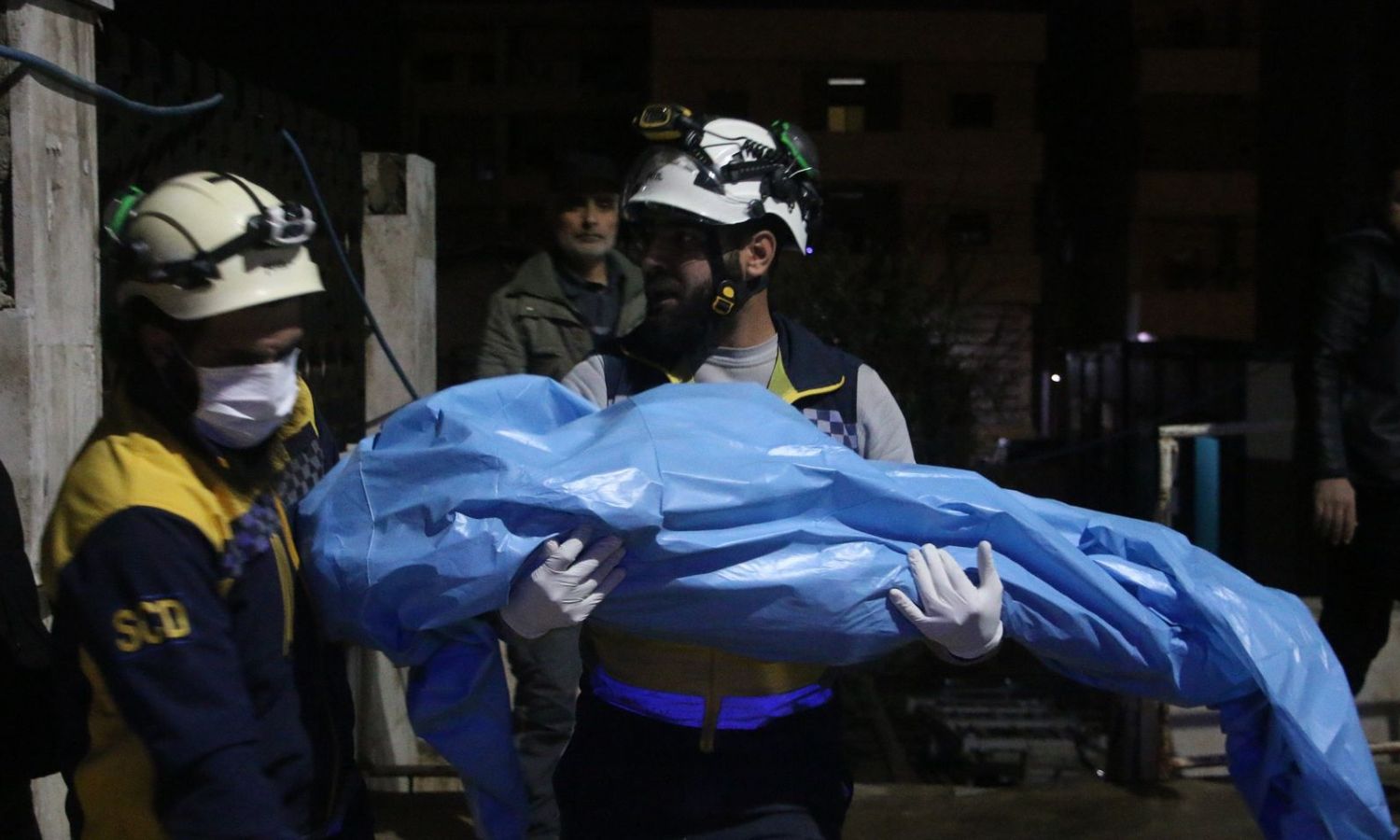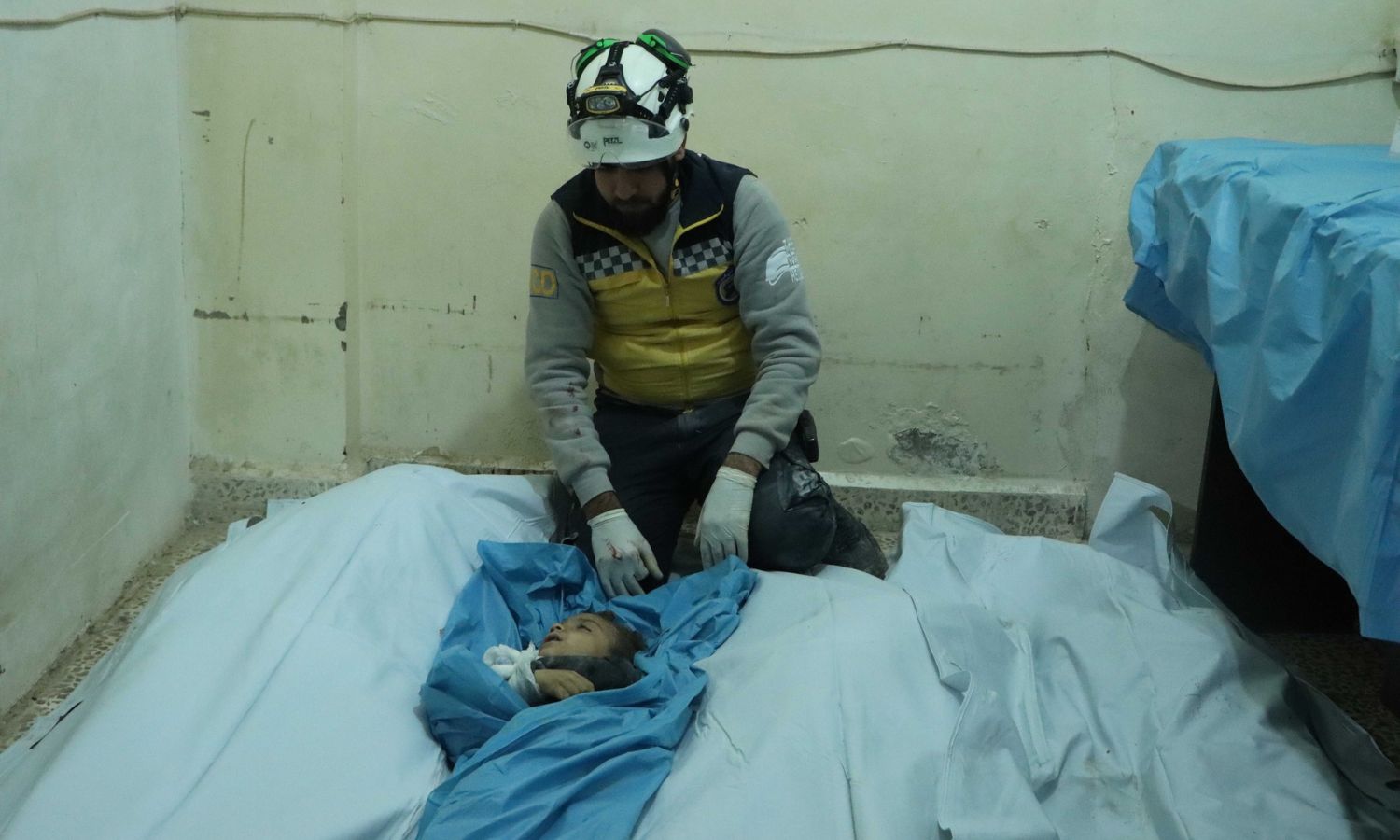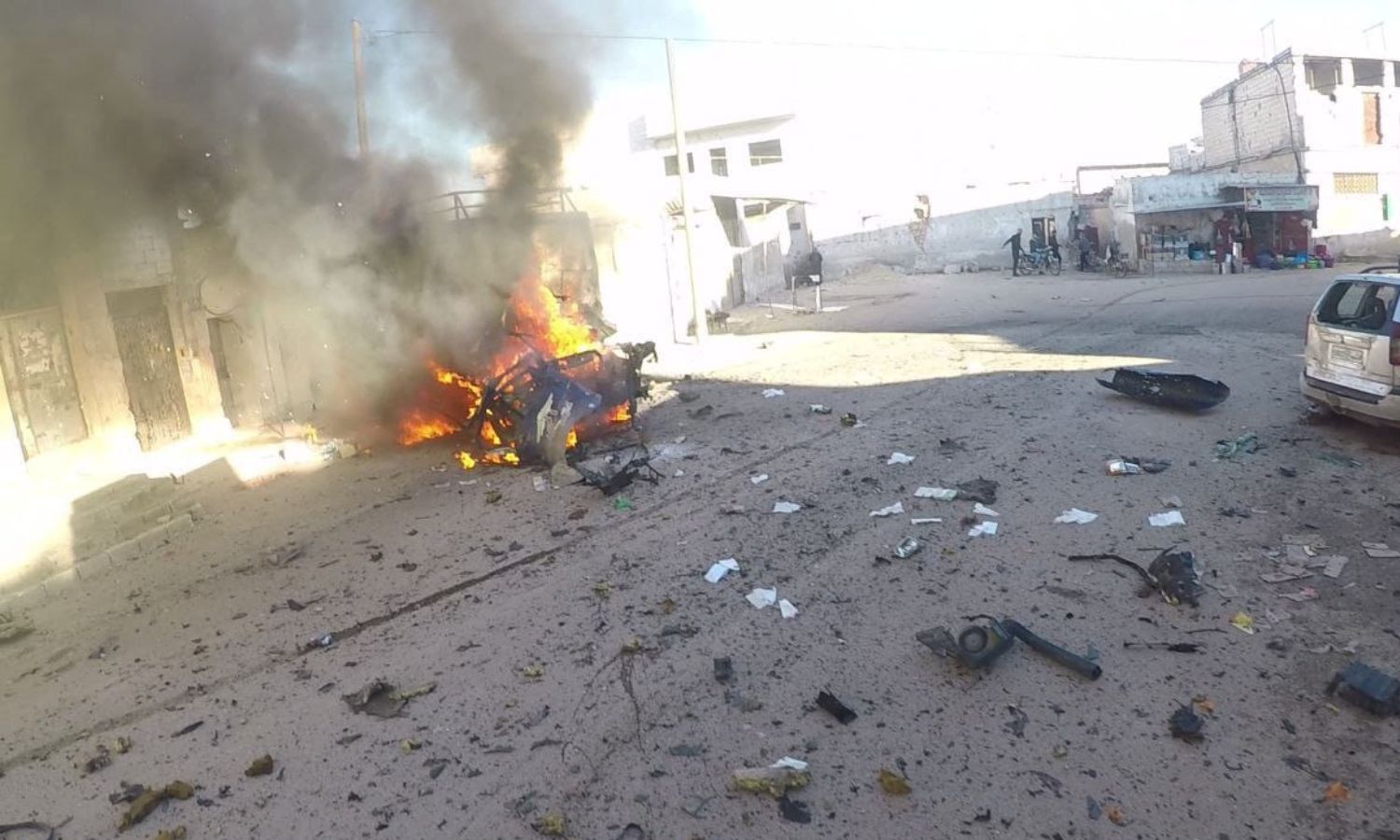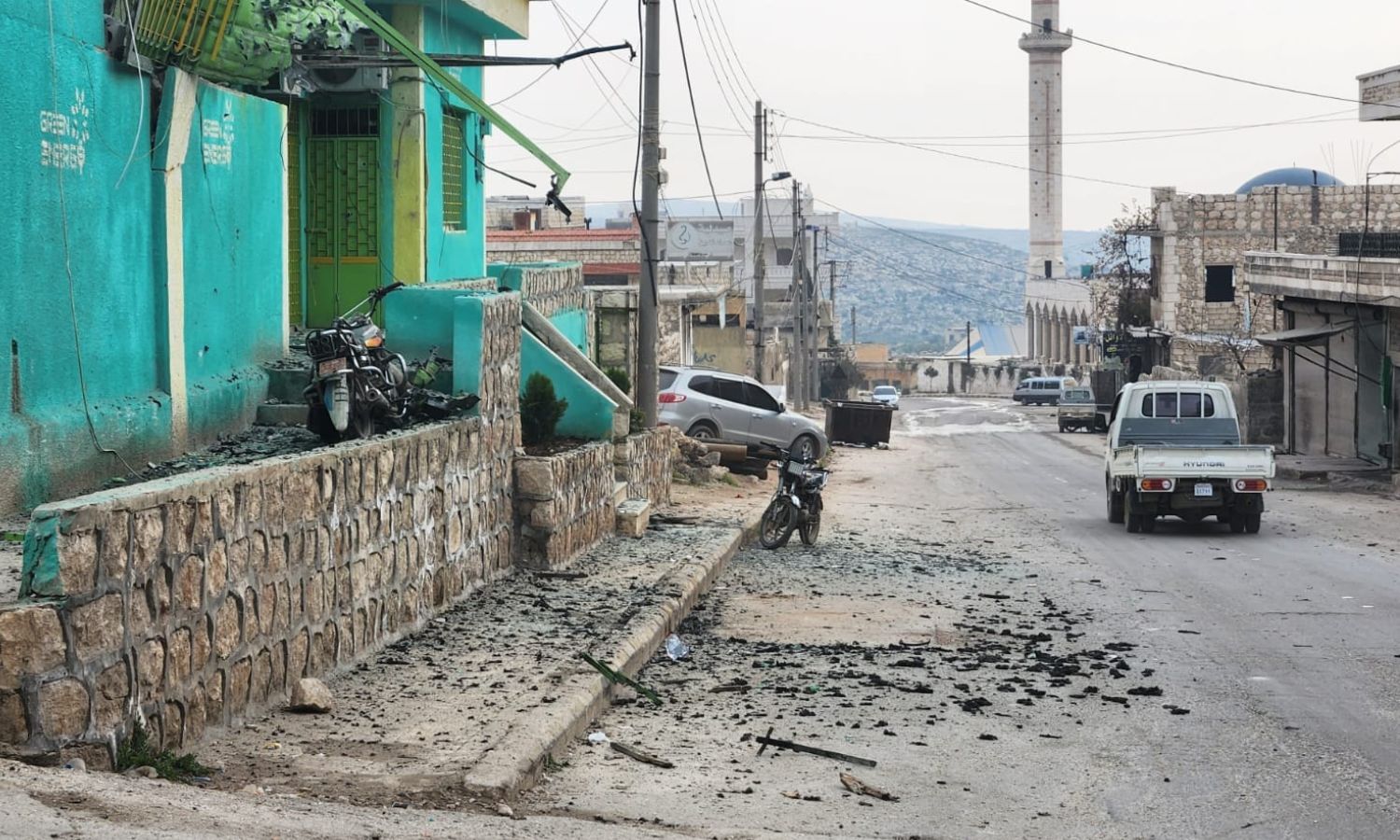



Enab Baladi – Abdul Karim al-Thalji
“We hide under the rocks of our land until the wave of shelling ends; it is our shield and our refuge,” a phrase apt to describe the situation of Ali Daroubia, a resident of the town of Ihsem in the Jabal al-Zawiya region, south of Idlib, similar to the situation of residents in the frontlines of northwestern Syria.
In the latest wave of shelling, Daroubia sent his wife and children to a safe place while he stayed to guard his land, holding onto it. He told Enab Baladi that the state of shelling and military escalation by the regime forces and its allies has not subsided on Jabal al-Zawiya since its sons rose against the regime in the Syrian revolution in 2011.
He mentioned that Jabal al-Zawiya after it exited the regime’s control in 2012, was exposed to continuous shelling by the regime forces, its militias, and Russia and lost many of its inhabitants. Not a week passes without casualties from the shelling, despite the regime forces stopping at its doorstep after a large-scale military operation they carried out in late 2019.
With the escalating pace of shelling in northwestern Syria, the fears and concerns of the residents near the frontlines are increasing, fearing a repeat of the displacement scenario at the beginning of 2020, which led to the displacement of nearly a million people from the countryside of Idlib, Aleppo, and Hama.
“We gained strength and clung to the land from the rocks of Jabal al-Zawiya, and this situation has become almost normal for the mountain’s residents,” Daroubia added, but he also noted that “the fear of displacement remains present with every rocket or artillery shell that hits the area, in addition to the constant reconnaissance aircraft flights that give indications that we are still in a state of war.”
As soon as you enter the Jabal al-Zawiya area from the north, you feel as if you are in a state of war, and you must consider that you are exposed to death at any moment from an artillery shell or an air raid from a fighter plane or a suicide drone, Daroubia said.
Most of the mountain’s residents have alternative housing, either with relatives or in a tent in one of the camps away from the frontlines with the regime forces or near the Syrian-Turkish border.
Most of the residents of the Jabal al-Zawiya area, especially those close to the frontlines, have prepared simple shelters to protect themselves from the shells of the regime forces and its missiles, as Jabal al-Zawiya is the first line of defense for the northwestern region of Syria.
Jabal al-Zawiya has a strategic location that has made it of great importance to both the regime and the opposition, as it is the safety valve for Idlib and northern Aleppo and overlooks the international highway (M4) that connects the province of Aleppo with the areas of the coast in western Syria.

A massacre claimed the lives of five civilians from a single family, committed by Russian aircraft in the village of Alata near Armanaz, west of Idlib – December 25, 2023 (Syria Civil Defense)
The situation in Sarmin, al-Nairab, Afs, and Maarat al-Numan is no different from that of Jabal al-Zawiya, and perhaps even more difficult, as the rugged mountainous terrain may be a factor contributing to the protection of the people, unlike the mentioned villages, which are subjected to almost daily shelling, leading to a decline in their civilian life.
On January 6, four civilians were injured, and a civilian car caught fire as a result of missile shelling by regime forces targeting the popular market and civilian homes near a high school in Sarmin.
According to several residents of Sarmin, the city is experiencing difficult humanitarian conditions. It has recently been subjected to intense shelling following a violent escalation in October of last year, which led to the destruction of several schools, health centers, and public facilities and resulted in the displacement of a large portion of the inhabitants outside the city.
The residents were forced to return to their city due to their inability to bear the burdens of relocation and the high cost of renting a new house, in addition to their lack of adaptation to living in collective shelters or camps, as most residents rely on their agricultural lands as their main source of income and their businesses, which provide for their daily expenses. This has led them to return under the shelling.
The city of Sarmin is located less than eight kilometers from the areas controlled by the regime forces in the city of Saraqib, being a neighboring area to the frontlines of the fighting.

Syrian regime shelling on Sarmin in the eastern countryside of Idlib – January 6, 2024 (Syria Civil Defense)
The intense shelling did not stop over the past three months on the neighboring town of al-Nairab near Sarmin, especially after an attack targeted a graduation ceremony for officers in the Military College in Homs. As it has been and was intermittently subjected to shelling over the past years, according to Abd al-Qadir al-Daj, the head of the local council in the town.
Al-Daj told Enab Baladi that the shelling had led to paralysis in the civil movement in the town. The Directorate of Education in Idlib suspended school classes a few days ago in al-Nairab, Sarmin, Afs, Taftanaz, and Maarat al-Numan in the eastern countryside of Idlib in order to ensure the safety of the students and the administrative and educational staff.
Al-Daj pointed out that the area has witnessed a large displacement in the recent period after the escalation, but people soon returned to their homes in the face of difficult living conditions, as these areas are originally close to the frontlines and suffer from a lack of humanitarian aid, in addition to their fragile infrastructure, as they were the first line of conflict and the vast military campaign launched by the regime forces in early 2020 stopped at their doorsteps.
Al-Nairab and Sarmin are close to the areas under the control of the regime forces in the city of Saraqib, keeping them prone to the shelling that threatens the lives of their inhabitants, with the constant fear of displacement haunting them, yet some of the residents chose to stay in these areas.
According to some residents of the town of Al-Nairab, the town’s people cling to their land despite the deteriorating living reality and the significant destruction that has befallen the town. When the shelling intensifies, most of the people leave to safer areas and then return to their homes and land when the shelling subsides.
The Syria Civil Defense rescue agency recounted in a report that the city of Sarmin has been the most shelled city in 2023, with a high percentage of destruction, as it was a theater for military operations.
As a result of the intense shelling that the city of Darat Izza in the western countryside of Aleppo was subjected to, families were displaced to camps and neighboring villages amidst fears of an escalation in the shelling, which threatens the lives and properties of the inhabitants.
The death toll of the shelling by regime forces on the city of Darat Izza and the villages of Burj Haydar and Kabashin in the western countryside of Aleppo has risen to six civilian fatalities and 11 injuries on January 1 of this year.
Ahmed Rashid, a journalist in Darat Izza, told Enab Baladi that the recent shelling in the city has reintroduced the specter of displacement and instability to the minds of the city’s residents, especially among the internally displaced.
He added that Darat Izza has half the population it had before the military operations in 2020, and due to the frequent shelling, numerous families have fled the city, despite its geographical importance as it connects the northern countryside of Idlib with the northern countryside of Aleppo.
He mentioned that the residents live in a state of constant fear of displacement, as not a day passes without the city or its surroundings being subjected to missile and artillery shelling from the points of the regime forces stationed in the western countryside of Aleppo, while the residents take refuge in the shelters they have dug between the rocks when the shelling intensifies.
Those who have chosen to stay in the city prefer to coexist with the shelling as life goes on, and most people do not have the financial means to rent new houses and bear the burden of moving home furnishings and belongings amid the high cost of living in the area, according to Rashid.
Over the past few days, the shelling has resulted in a halt in the education process, especially with the fears of the parents to send their children to school, as the “Aisha al-Kubra” school in the city was targeted, and the shelling threatens the health sector due to the targeting by the regime forces of vital facilities.

The aftermath of the shelling by regime forces on the city of Darat Izza in the western countryside of Aleppo – January 1, 2024 (Syria Civil Defense)
Darat Izza’s situation is not different from the rest of the cities and towns in northern Syria close to the frontlines with the regime forces, especially Tukad, al-Abzimo, al-Atarib in the western countryside of Aleppo, Maarat al-Numan, Afs, Taftanaz, Sarmin, and al-Nairab in the eastern countryside of Idlib, in addition to the Jabal al-Zawiya region in the south of Idlib.
The Syria Civil Defense documented in a report at the end of 2023 the killing of 162 people and the injury of 684 others due to the attacks by the regime forces and its ally Russia during 2023.
The Civil Defense teams responded to more than 1,276 attacks by the regime forces, Russia, and their affiliated militias from the beginning of 2023 until December 24 of the same year, in which 160 people were killed, and 688 were injured.
if you think the article contain wrong information or you have additional details Send Correction